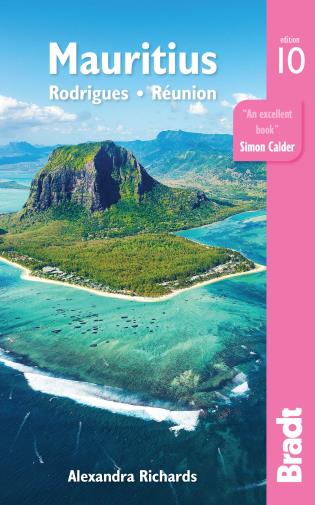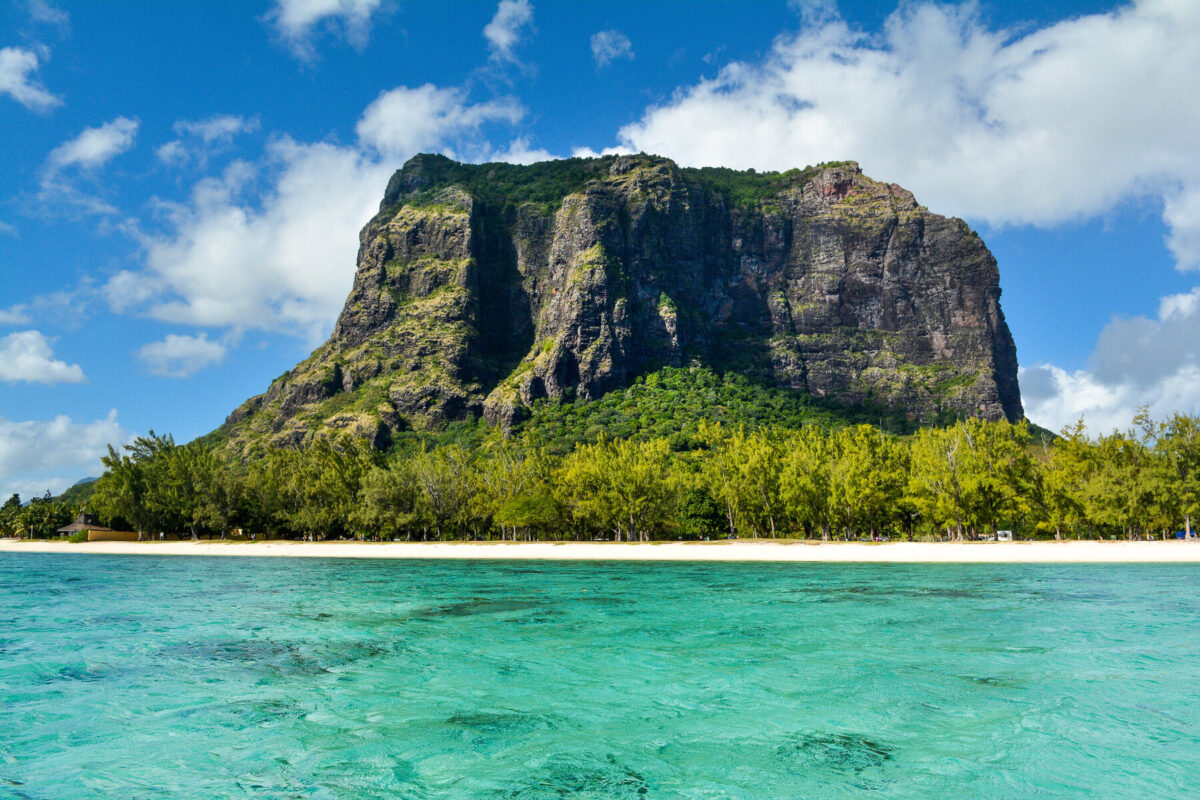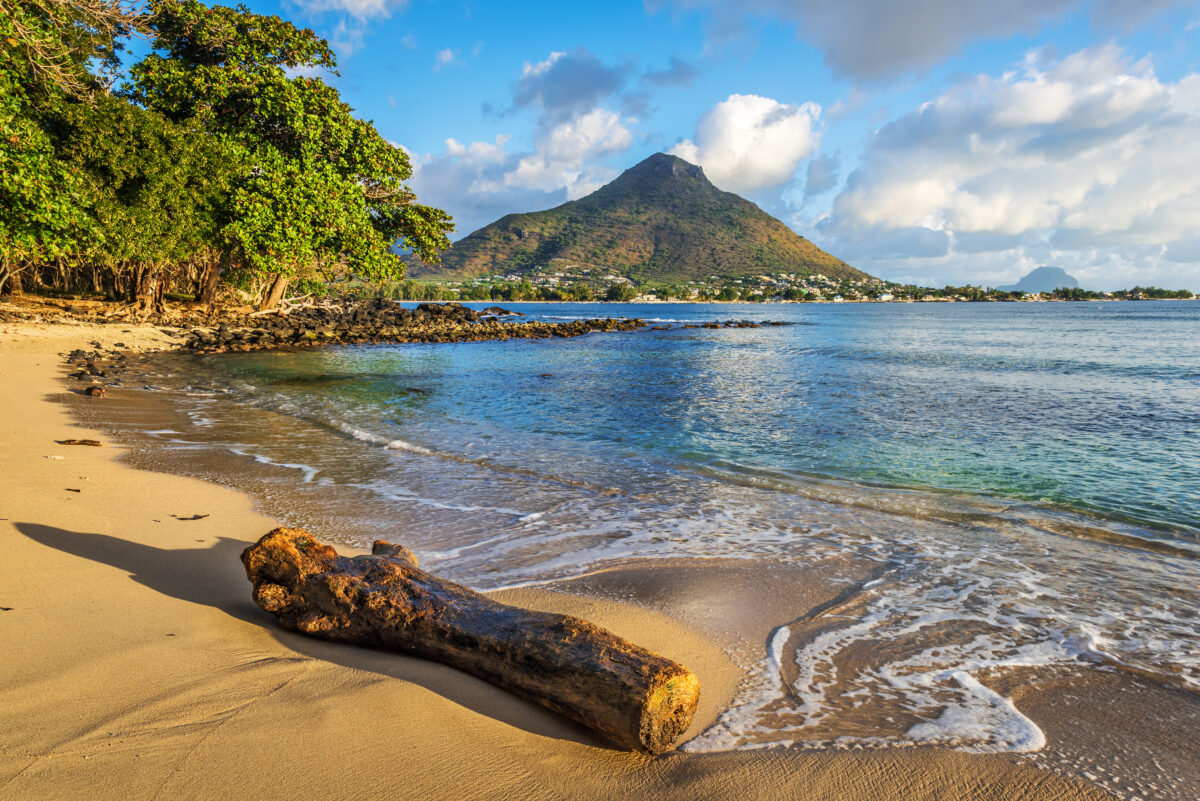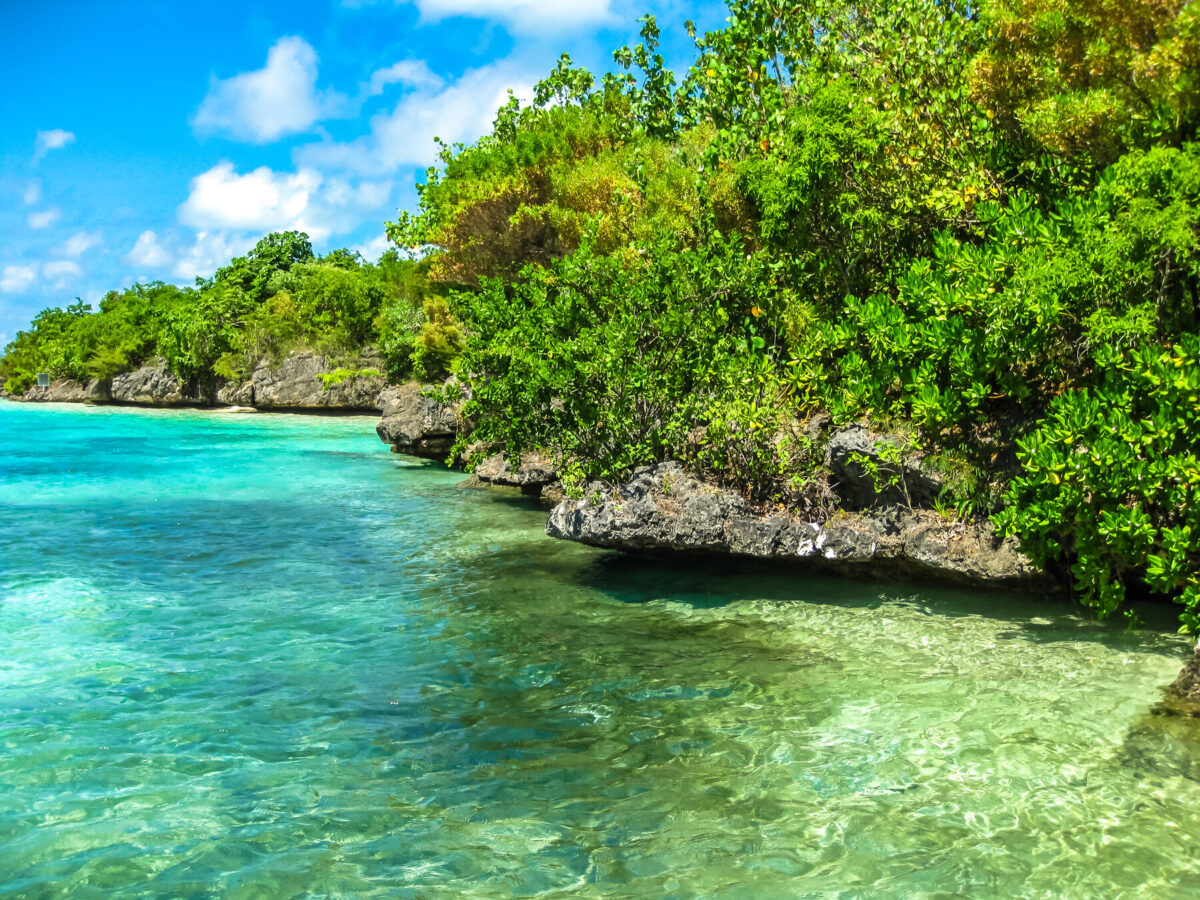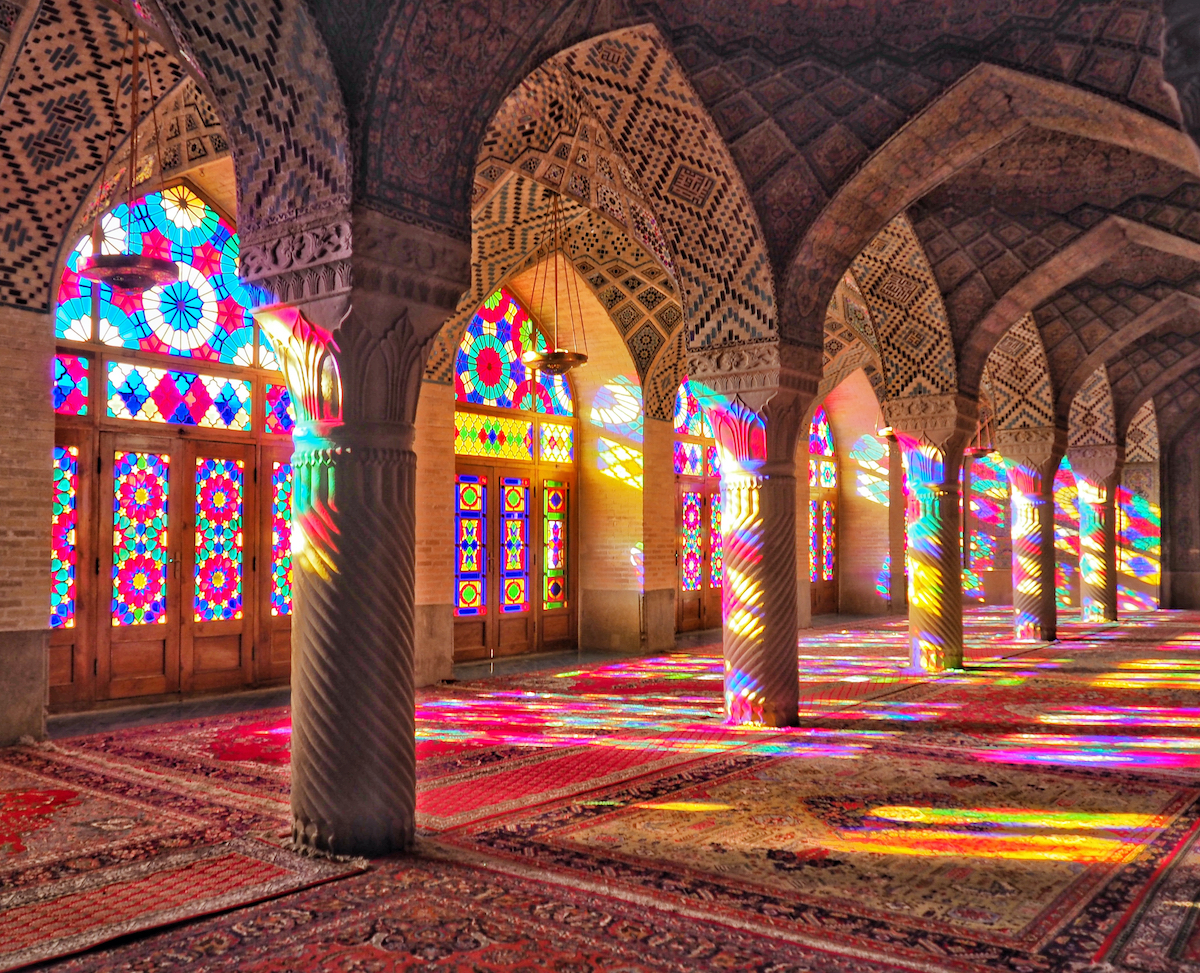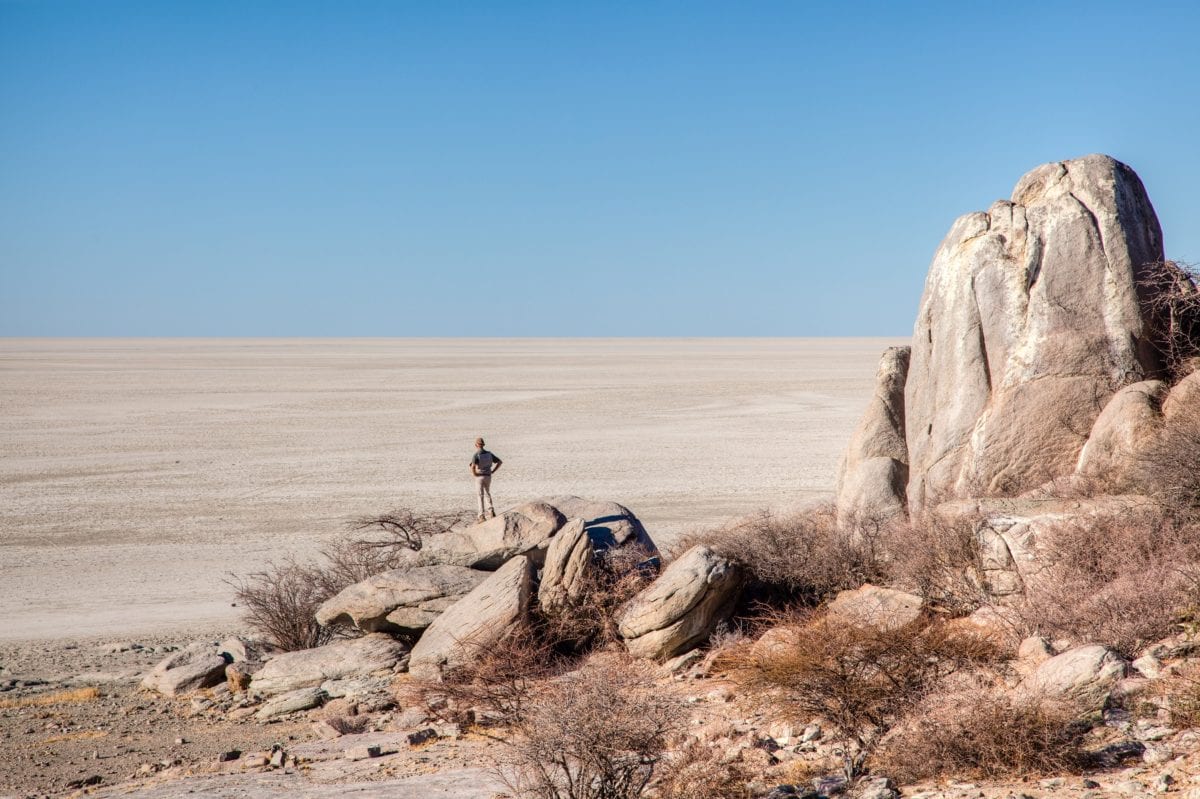It is easy to see why Dutch, French and English colonists spent hundreds of years tripping over themselves, and each other, to settle on the previously uninhabited Mascarene Islands.
Alexandra Richards, author of Mauritius: The Bradt Guide
Plenty of holiday destinations offer stunning beaches, tropical warmth and fancy hotels but there are a few things that set Mauritius apart from its competitors.
Firstly, and importantly during this era of increased threat to the global security environment, Mauritius is a comparatively safe destination. It is a relatively stable democracy with little serious crime and few health risks. Secondly, the service in the hospitality industry is exceptional; even mid-range hotels boast levels of service you would be lucky to find in a five-star hotel elsewhere.
An immensely rich culture is another standout feature, the result of those eager European colonists bringing a cocktail of African and Indian people to the island, as well as Chinese migration. The blend of cultures is reflected in the fabulous cuisine, and memorable meals are to be had both in the island’s world-class restaurants and at roadside food stalls selling cheap samoussas and curries.
While it may be tempting to stay within the confines of your luxury resort and make the most of the facilities, the real Mauritius lies right outside its gates and is easy to explore. Flamboyant temples and grand colonial mansions stand as monuments to the island’s colourful past and present. A working tea plantation, sugar factories and rum distilleries are open to the public and make for fascinating, and tasty, excursions. Some of the large rural estates (or domains) have opened to the public and offer activities such as horseriding, canyoning and quad biking. Mauritius was the home of the dodo before it became extinct and, while I don’t like your chances of spotting one of those in the wild, there is plenty of interest for nature lovers, such as tours of Île aux Aigrettes nature reserve and hiking in the Black River Gorges National Park.
However you choose to spend your time on Mauritius, your journey to this beautiful African island promises to be a truly unforgettable experience.
Food and drink in Mauritius
Food
Just thinking about the food in Mauritius is enough to make your mouth water, from the delicious French-style crêpes served with local vanilla tea for breakfast to the delight of salade de palmiste (heart of palm salad) and the beguiling taste of fish vindaye (fish curry) for lunch, then a dinner of samoussas and gâteaux piments (chilli bites) from a street stall.
Many of the island’s top hotels have superb fine-dining restaurants and attract world-class chefs. Most hotels make an effort to showcase local cuisine and will have Creole and Indian nights at least once a week.
The true adventure of eating in Mauritius, however, is for the streetwise, since so many delicious – and cheap – dishes are available from roadside stalls or small restaurants that specialise in Creole food or European dishes with a local zest.
The influences on Creole cuisine are African and Indian, with a dash of French. The recipes of slaves and indentured labourers have been blended with French ingenuity to produce an array of irresistible dishes, most of which are mildly spiced. The Chinese influence has been confined to particular areas, such as mine (noodles) and the ever-popular fried rice.
A favourite local dish, available from street vendors, is dholl purées: thin pancakes, made from wheat-flour dough and ground split peas and cooked on a griddle. They are served plain, or rolled around a spoonful of rougail or brèdes, and wrapped in paper. The India-originating purée, with its African/French filling, is an example of Mauritius’s successful blend of culinary traditions. Rougail is a spicy condiment often made with pommes d’amour, the tiny cherry tomatoes that are grown and eaten all over the island. Brèdes are part of the daily diet of Mauritian country dwellers, cooked either plain or with meat or fish. They are green leaves – such as watercress, spinach, the leaves of tuber plants and Chinese cabbage – tossed with onions, garlic and red chillies in hot oil until the water has evaporated.
More substantial meals are also available from street sellers, such as poisson vindaye, seasoned fried fish coated with a masala of mustard seeds, green chillies, garlic and turmeric, often eaten cold with bread. Achards légumes, pickled vegetables mixed with spicy paste and vinegar, are also sometimes eaten with bread.
Drink
A popular Mauritian drink is alooda, sold on the streets and in markets by energetic salesmen praising their own product. It consists of dissolved, boiled china grass (agar agar) and sugar, which has been strained and allowed to set and then grated, to which is added water, milk, rose syrup and soaked tookmaria (falooda) seeds.
As you would expect, beer, wine and spirits are far more expensive in hotels than they are in local shops. Be sure to try some of the local rums produced on the island that are available in most bars. Many households and watering holes keep a variety of rhum arrangé, made by adding their own choice of fruit and/or spices to a large bottle of rum and leaving it to mature for a few months.
Travel and visas in Mauritius
Visas
To enter Mauritius, you will need a passport valid for the full duration of your stay, proof of a return or onward ticket and the address of confirmed accommodation on the island. To be on the safe side, it is recommended ensuring your passport has at least six months validity beyond the end of your stay.
Tourists travelling on passports from the following countries are among those who do not require a visa: the UK, European Union countries, the US, Canada, Australia, New Zealand, Israel, Botswana, South Africa, Zambia, Zimbabwe, Norway, Sweden, India, Russia and China. As the UK is no longer a member of the European Union, documentation requirements for UK citizens may change. Check before travelling.
Holders of passports from certain other countries are granted stays of a limited duration on arrival; for instance, visitors from Comoros, Madagascar and Nigeria are granted two weeks, while visitors from many Latin American and African countries are granted 60 days. For those travelling on passports from some other countries, a visa is required prior to travel; for instance, Pakistan, Philippines, Indonesia, Mali, Somalia and Sri Lanka. Entry requirements change, so please check the MTPA website or the Passport and Immigration Office website.
Getting there and away
A package including flights and hotel accommodation is one of the most cost-efficient and popular ways of visiting Mauritius. Many tour operators offer visits to Mauritius in combination with another destination; it is an ideal spot for a week’s relaxation after a safari in Africa. Booking your flights and accommodation as a package need not restrict your freedom to explore the island.
By air
It takes around 12 hours to fly to Mauritius direct from Europe. The fact that it is a long way and that there are few cheap charter flights has helped Mauritius preserve the qualities that make it attractive.
Air Mauritius and British Airways each offer non-stop flights from London: Air Mauritius operates direct flights from Heathrow, while British Airways flies direct from Gatwick. Additional flights via Johannesburg, South Africa, depart from Heathrow. Emirates offers flights via Dubai, where you can choose to stop over. It is also possible to fly via Paris with Air France.
By sea
In recent years, the Mauritian Government has pushed to improve port facilities and encourage more cruise ships to the island. The ships that call here are usually either on round-the-world voyages or cruising from southern and eastern Africa. A Costa Croisières ship is based in Port Louis from December to March and operates cruises in the region, taking in Réunion, Madagascar, the Seychelles and east Africa.
There are regular passenger sailings between Mauritius and Rodrigues, and a couple of services a year between Mauritius and Agaléga. For detailed information, contact the Mauritius Shipping Corporation.
Getting around
Driving
There are around 2,000km of decent, tarred roads throughout Mauritius. A well-maintained motorway crosses the island diagonally from the airport in the southeast corner, travelling through Port Louis and north to Grand Baie. Little-used country roads are not in such good condition and signage is minimal. Wherever you are driving, it is worth allowing more time than you think as, aside from the motorway, the roads are slower than you might imagine. It seems that whenever you ask a local how long it will take to get somewhere, the response is always ‘1 hour’, which magically seems to be about right!
Car and motorbike hire
The minimum age for hiring a self-drive car varies from 20 to 25 years, according to the hire company. All companies require that the driver has been in possession of a valid driver’s licence for at least one year. The car-hire company will need to view your licence. The rental must be paid in advance. Payment of a daily premium reduces the insurance excess and a daily driver and passenger personal accident insurance is available. Cars can usually be delivered and recovered anywhere on the island and there are car-hire desks at the airport.
There are few places offering mopeds and fewer still offering motorbikes, and it is risky to hire from an unofficial provider. Mopeds are available from around Rs600 a day, including helmet. Crash helmets are compulsory when driving or riding a motorbike or moped. Please avoid riding at night.
Taxis
One thing Mauritius is not short of is taxi drivers. Wherever you go, taxi drivers will wave animatedly at you, shout out to you, swerve in front of you, and do their best to persuade you that you need their services. Although most taxis now sport nifty modern meters, they are rarely used. It is as well to negotiate a fare before you start your journey but be prepared to bargain.
When to visit Mauritius
The high season for tourism, when holiday packages cost more, is November to early January. Hefty peak-season supplements are charged over Christmas and Easter. Flights should be less crowded outside European school holiday periods and hotels are noticeably so.
Climate
Mauritius’s tropical climate means it offers warmth all year round; summer is hot and wet (November to April), winter is warm and dry (May to October).
The one time when it is not ideal to visit is January to March, when cyclones are most likely to occur. They don’t happen every year but the cyclonic rains, which can last for several days, are an annual event and you could find yourself confined to the indoors for a portion of your stay.
The weather is cooler from June to September with the temperature at sea level being about 22°C, and it can be windy at this time, more so on the east coast than the west. Package holiday prices are lower and hotels tend to host conference and incentive groups. September to October is perhaps one of the best times to travel as the weather is good but peak-season prices and crowds have not yet set in.
Festivals and public holidays
If climate is not the governing factor, choose when to visit according to your interests. For instance, the horse-racing season is from May to late November and the best deep-sea fishing and diving lasts from November to May. Also in November, the island’s colourful flame trees wear the red/orange flowers that give them their name, and December is when local tropical fruits such as lychees are in abundance.
You may also like to time your visit to coincide with one or more of the island’s many colourful festivals:
Chinese Spring Festival – variable (January/February)
Thaipoosam Cavadee – variable (January/February)
Abolition of Slavery – 1 February
Maha Shivaratree – variable (February/March)
National Day – 12 March
Ougadi – variable (March/April)
Itineraries
If you want to view and compare speficic itineraries, please see the Mauritius beach holidays on SafariBookings. This comparison website lists tours offered by both local and international tour operators.
What to see and do in Mauritius
Port Louis
Port Louis is sandwiched between the Indian Ocean on one side and the Moka mountain range on the other. It is a chaotic but charming city, where pretty colonial buildings and sleek modern office blocks stand shoulder to shoulder, and the streets are invariably clogged with traffic and pedestrians.
Mauritius’s colourful history and diverse cultures are displayed in concentrated form here. A walk around the city takes you from imposing colonial buildings to bustling Chinatown, past the island’s largest mosque, through the lively market and onwards to the smart modern waterfront, with its upmarket shops and cruise-ship terminal.
The waterfront
The waterfront makes for pleasant wandering. With a wide esplanade and modern architecture, it is quite a contrast to the crowded narrow streets and wonky old buildings of the city centre. The very smart Caudan Waterfront sits on a peninsula jutting into the harbour. This modern complex includes apartments, offices, a cinema, bank, museum, casino, craft market, shops, restaurants, and a commercial art gallery.
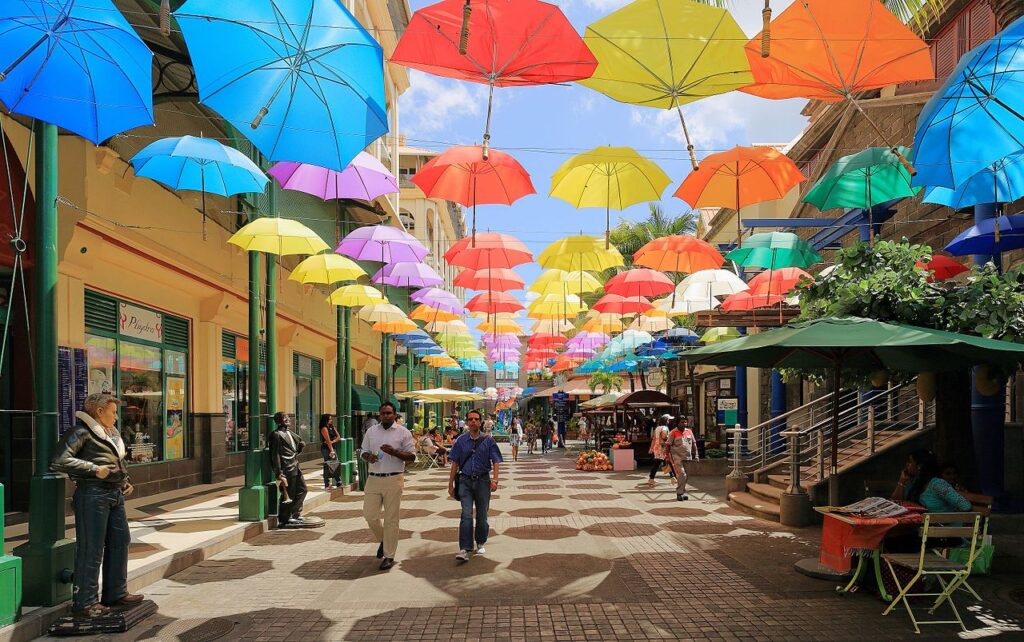
While the waterfront all seems rather modern, elements of the city’s history remain tucked away here. The building known as the Observatory, located near the Caudan Waterfront Shopping Centre, was built in 1832 on the site of an old French powder magazine, and was the first meteorological observatory in the Indian Ocean. Near the Astrolabe Centre is a restored 18th-century windmill. It was built in 1736 to grind wheat but was converted to a signal tower after the British took possession of the island in 1810. Restored in 1998, it now contains a small museum displaying historic photographs of the harbour and the history of wheat. From upstairs in the windmill you get a good view of the working harbour and the attractive, restored Creole building, with wooden shingle roof, which houses the National Coast Guard.
Blue Penny Museum
This small, well-laid-out museum is fascinating for anyone interested in philately, but equally worthwhile for anyone seeking an insight into the history of the island.
The stamp collection here centres around the famous Mauritian ‘Post Office’ stamps issued in 1847, which are some of the rarest in the world. A wonderful collection of paintings, photos, documents and nautical charts from the island’s colonial days is also on display. The shop sells books on the Mascarene Islands and souvenirs.
Postal Museum
An interesting, neatly laid-out museum within a stern Victorian granite-block building on the waterfront. It tells the story of the postal history of Mauritius from the issuing of the first stamp on the island in 1847 and the establishment of a coach service. On display is some of the equipment used in post offices over the years, as well as cancelling machines, letter boxes and vending machines.
The collection of stamps is impressive, and includes an original penny black. It arrived in Mauritius because when the engraver began work on Mauritius’s first stamp, he copied from the penny black.
Aapravasi Ghat
At the northern end of Port Louis’s waterfront, beyond the postal museum, is Aapravasi Ghat. This glum-looking immigration depot was built in 1849 to process labourers as they arrived and is now a UNESCO World Heritage Site. Between 1834 and 1923 almost 500,000 indentured labourers arrived in Mauritius to replace the labour lost following the abolition of slavery in 1835. While many worked in the island’s sugar plantations, others were transported from Mauritius to other British colonies.
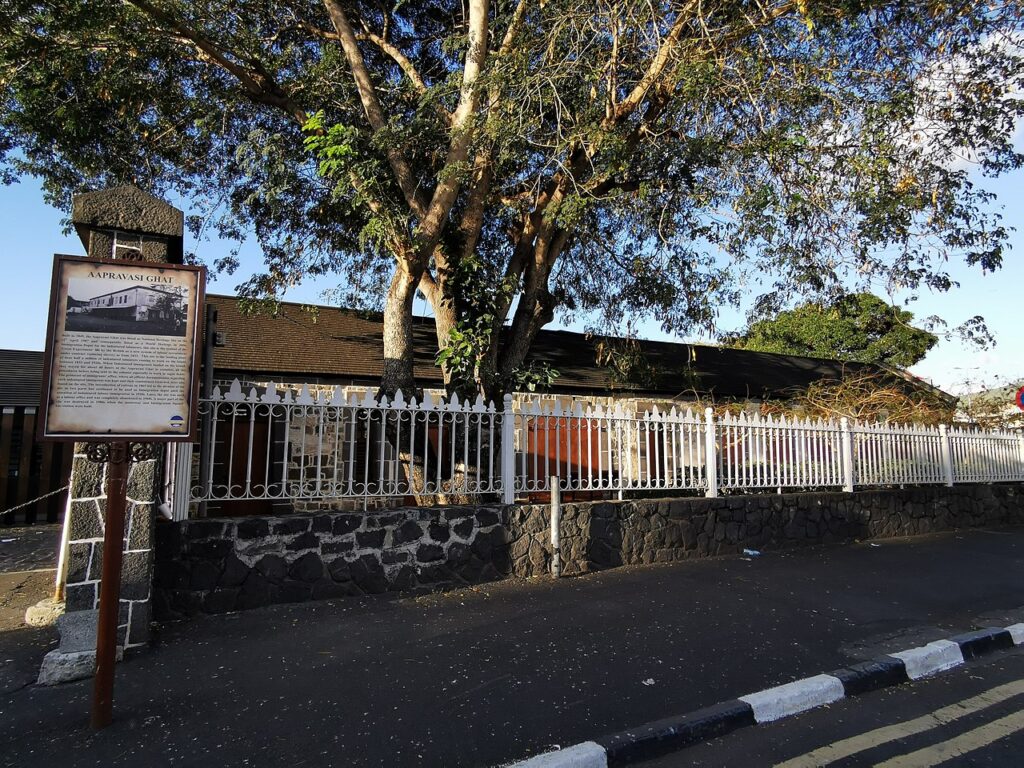
A well-laid-out modern visitor centre explains the history of indentured labour in Mauritius and provides an insight into the origins of the island’s population. The depot originally consisted of a gatekeeper’s office, hospital block, kitchens, immigration office, other staff offices, sheds, stables and privies. Today only parts of it remain, including the gatekeeper’s office, hospital block, wharf steps and immigrants’ sheds.
The city
On the other side of the main road from the harbour is the city. Tall royal palms form an avenue of greenery leading from the waterfront up the centre of Place S Bissoondoyal (formerly Place d’Armes) to Government House. The name was officially changed from Place d’Armes to honour a Mauritian politician and independence leader but many locals still refer to it by its old name.
A handsome white colonial building, Government House dates back to 1738 when Governor Labourdonnais built the ground floor and the wings that form the forecourt’s sides from stone. Nearby is a statue of Sir John Pope Hennessy, the most outstanding governor of the latter part of the 19th century (1883–89), sympathetic to calls of Mauritius for Mauritians.
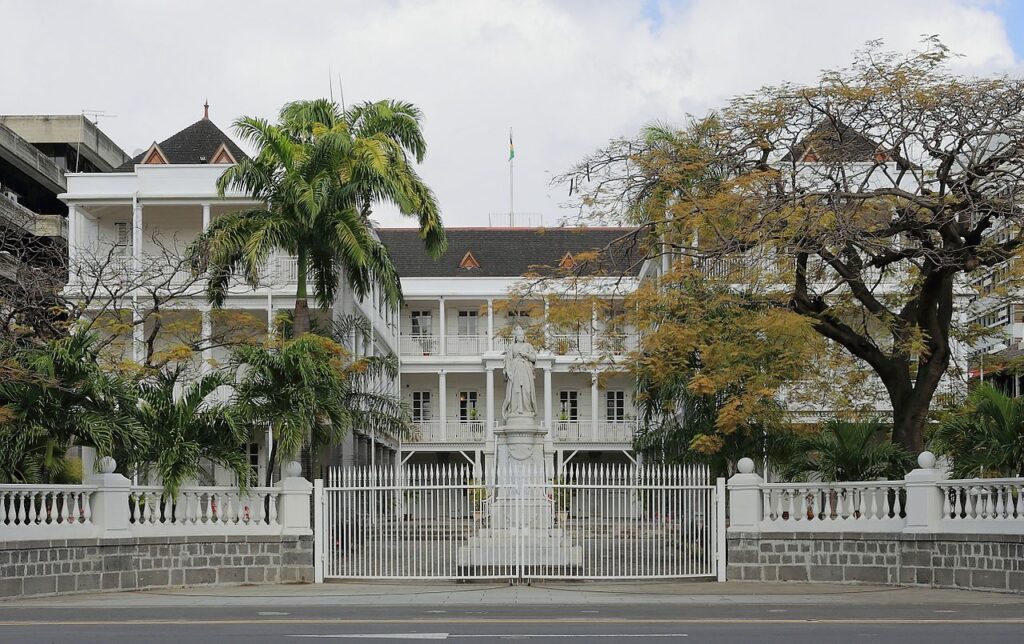
From the Company Gardens (home to just under a hectare of narrow paths, flower beds, shrubs and ponds), head to the Municipal Theatre. It was opened in 1822 by Sir Robert Farquhar, the island’s first British governor, and is said to be the oldest theatre in the Indian Ocean. The interior is decorated in the style of a classic London theatre, with a domed ceiling painted with cherubs. The theatre’s first production was La Partie de Chasse de Henri IV performed by a Creole amateur troupe.
In the east of the city centre, the Jummah Mosque, with its ‘wedding cake’ architecture, is, unsurprisingly, on Jummah Mosque Street. The mosque extends an entire block, its white towers and friezes imposing grace on the clutter of lock-up shops beneath its balconies. Its huge teak doors are priceless, ornately carved and inlaid with ivory. The muezzin’s call from the minaret before dawn is the signal not only for prayer but also for the cacophony of the city to erupt. In the courtyard is an old badamier tree, older than the mosque itself.
The Citadel
The best viewpoint from which to appreciate the city is the Citadel, also known as Fort Adelaide. Viewed from here, the layout of the city is uncomplicated: rectangular street blocks as far as the eye can see, with the Indian Ocean stretching out beyond. Aside from the view and the shops, however, there isn’t a lot to make you linger, so a short visit (less than 30 minutes) should suffice. On the plus side, entry is free.
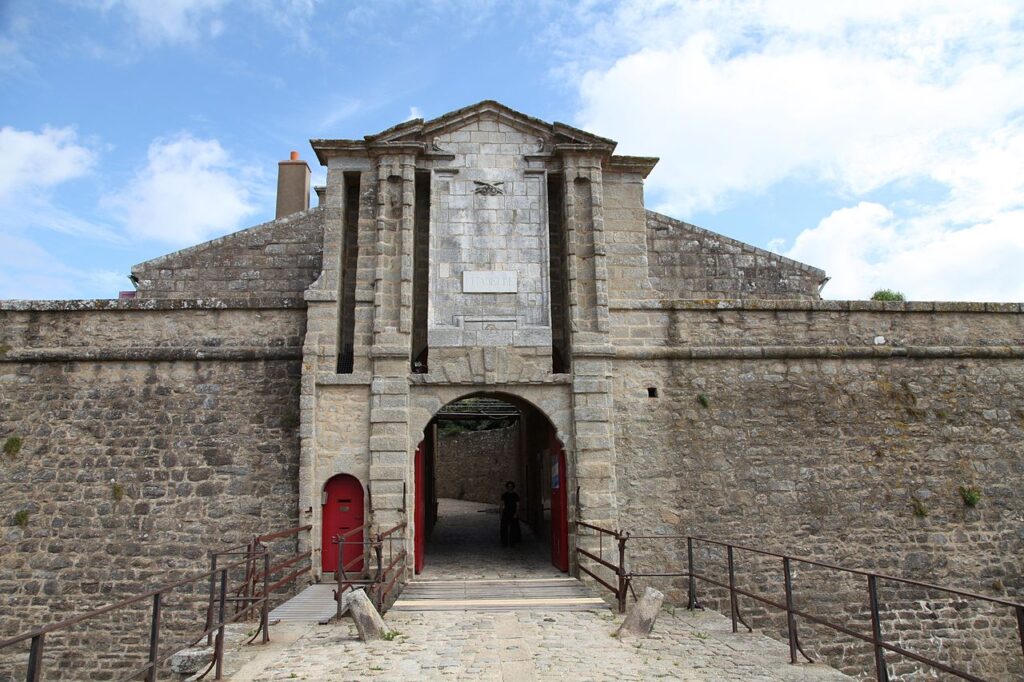
The Champ de Mars racecourse is clearly visible from the fort and on race days you will find crowds of Mauritians watching the action here. The large green shed you can see by the harbour stores the island’s sugar before it is transferred to ships for export.
Île aux Cerfs
The uninhabited sand island of Île aux Cerfs, off Trou d’Eau Douce, is one of the best-known tourist attractions of the east, with its miles of beaches, copious watersports facilities and championship golf course belonging to Shangri-La Le Touessrok Resort.
It is marketed as a ‘paradise island’ and is a popular excursion, but many travellers find it too touristy and overpriced. The island has a total area of 300ha, much of which has been transformed into the superb Île aux Cerfs Golf Course. Local operators selling trips to Île aux Cerfs line the road through the village, clamouring for the attention of tourists. This can be rather off-putting, but almost all hotels can organise the excursion.
If you walk far enough around from the boat landing area, you should be able to find a quiet spot on the beach. Once you’ve settled down, it probably won’t be long before a passing gentleman offers you a pineapple or coconut. It’s almost worth the Rs100 just to watch him expertly hack the pineapple into the classic ice-cream-cone shape.
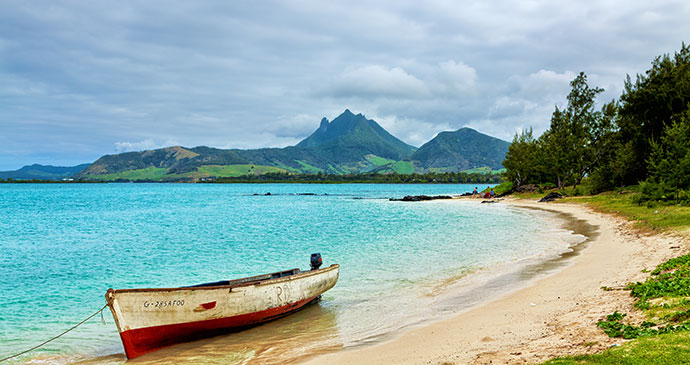 The uninhabited Ile aux Cerfs has miles upon miles of gorgeous beaches © hessbeck, Shutterstock
The uninhabited Ile aux Cerfs has miles upon miles of gorgeous beaches © hessbeck, Shutterstock
For a slighty different kind of activity, check out TerrOcean. Operating near Domaine de l’Etoile, this company runs obstacle courses on the island, one for adults (think rope bridges, Tarzan swings, and the like) and one for children (4–11 years).
For those whose accommodation doesn’t provide trips to Île aux Cerfs, there are other ways of getting there. Almost every second person you pass in Trou d’Eau Douce will offer to take you there but be wary as their service may not be reliable, particularly when it comes to bringing you back again.
Operators with reasonable reputations include Vicky Tours and Falcon Boats, both of which have sales representatives in Trou d’Eau Douce. Expect to pay around Rs300 per person return by ordinary boat, which takes around 15 minutes, or around Rs450 by speedboat, which only takes around 5 minutes. Boats leave at regular intervals, usually every 30 minutes between 09.00 and 16.30, but you should confirm with your particular operator the time of the last trip back to the mainland. The departure point is clearly marked in Trou d’Eau Douce and you can buy tickets on the spot.
A number of operators, including Falcon Boats and Vicky Tours, offer full-day group excursions to Île aux Cerfs, which usually include a barbecue and a visit by boat to the small waterfall at Grande Rivière Sud-est. Such excursions cost around Rs1,000 per person. A visit to the waterfall and Île aux Cerfs without lunch costs around Rs700.
Île aux Aigrettes
This coral islet is a nature reserve managed by the Mauritian Wildlife Foundation (MWF). Conservationists are working to restore it to its original state, by clearing exotic species of plants and replacing them with native ones. Endangered endemic birds and reptiles have been reintroduced to the island which is a safe haven for them away from introduced species such as rats, cats and monkeys which prey upon their young.
Visitors have a good chance of spotting rare pink pigeons, olive white-eyes, Mauritius fodies, Günther’s geckos and Telfair’s skinks as well as discovering fascinating plants, giant Aldabra tortoises roaming free in the wild and cannons left by the British after World War II.
A tour of this region starts with a short boat trip to the island, leaving from Pointe Jérôme, about 500m south of Le Preskil Island Resort. One of the MWF rangers will take you on a guided tour of the island and talk you through the flora, fauna and history. Being a coral island it is very hot, so remember to take a hat, water and mosquito repellent with you. There is a small exhibition on the extinct fauna of the Mascarenes, to highlight what has been lost already from the islands and the importance of the MWF conservation work.
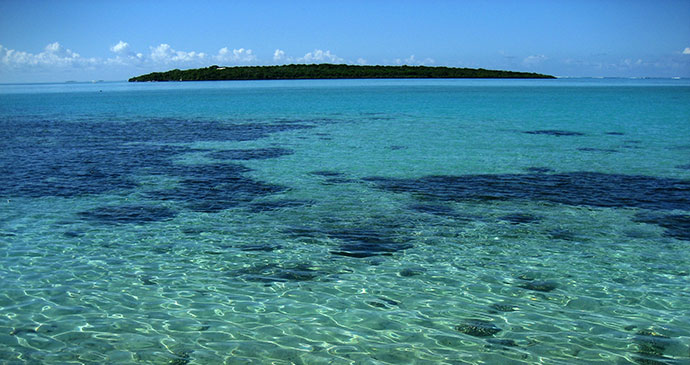 © Emma Jones, Shutterstock
© Emma Jones, Shutterstock
Tours start at 09.30, 10.00, 10.30 and 13.30, 14.00 and 14.30 (mornings only on Sundays) and last about 2 hours. It is money well spent as not only is the tour a fascinating insight into what the coastal forests of Mauritius would have looked like around 400 years ago, but part of the tour fee goes directly towards the continuation of MWF’s work. There is also a small shop on the island, where the money you spend benefits MWF’s conservation projects.
The MWF also runs tailor-made tours of the island, depending on your interest. For example, they can organise photography tours or tours for those with an interest in a specific conservation project. There is also the option to be a ‘conservationist for a day’, where a varied programme is offered, accompanying scientists while they carry out their daily tasks.
Bois Chéri Tea Estate
This working Mauritius tea factory turns 40 tonnes of tea leaves into ten tonnes of tea per day. Guided tours (which start at 09.30) take you through the whole process, from the drying of the leaves when they are first received through to the flavouring of the tea and finally the packaging. Much of the machinery is wonderfully basic and old-fashioned but still does the job. It is certainly worth taking the factory tour when it is operating, but be warned that the machinery is noisy.
Tours take place every 30 minutes in the mornings and in winter the factory usually operates only on a Wednesday, due to the reduced harvest. The main harvest season is October to March, and 80% of the picking is done by hand because only the young leaves are suitable. To see the tea pickers at work you will need to come early in the morning and on a weekday; they finish work by lunchtime to avoid the sun.
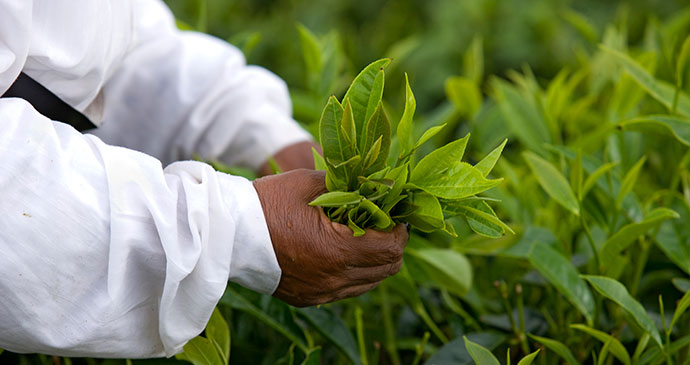 Tea is produced locally on the island and comes in a variety of locally inspired flavours, such as vanilla and coconut © Mauritius Tourism Promotion Authority
Tea is produced locally on the island and comes in a variety of locally inspired flavours, such as vanilla and coconut © Mauritius Tourism Promotion Authority
To the right of reception is a museum which charts the history of tea and exhibits various machines which have become obsolete over the 120 years that the factory has been in production. A short drive brings you to a wooden building overlooking a lake and tea bushes, where you can taste a number of the teas produced in the factory, such as vanilla, coconut and mint flavours. There is also a good restaurant here with views to the coast. Packets of tea are on sale in the shop and make a good souvenir or gift, starting from just Rs55 for a small pack of loose-leaf tea.
Tour buses seem to arrive around 11.00 and it can get busy at this time. The factory is closed on Sundays and public holidays but the restaurant, museum and tea tasting are open daily.
Black River Gorges National Park
The importance of Black River Gorges National Park is that it protects a phenomenal concentration of gravely endangered animals and plants. Visitors will not struggle to find some of its rare denizens, many of which have narrowly escaped extinction. If there is one place in Mauritius which nature enthusiasts must visit, this is it.
Set in the southwest, the national park covers 6,754ha and includes the Macchabée, Le Pétrin, Plaine Champagne, Bel Ombre and Montagne Cocotte forests. But don’t expect pristine natural landscapes: the remaining forest is severely degraded, having been thoroughly invaded by fast-growing exotic plants.
At Le Pétrin and Plaine Champagne, you’ll find heath-type vegetation flourishing on porous soil (keep a lookout for the lovely Trochettia blackburniana). Pandanus (Pandanus microcarpus), known locally as vacoas, thrives where terrain is marshier. A very distinctive tree is the weird, umbrella-like bois de natte (Labourdonnaisia glauca), often festooned with epiphytes.
At Bel Ombre, you can study the transition between lowland and upland evergreen rainforest, while at Montagne Cocotte, there’s a good example of high-altitude rainforest, in which shorter trees are draped in mosses and lichens.
The visitors’ centre at Le Pétrin is home to a wealth of information on how the national park can best be enjoyed. The main thing to do here is hike and the following trails are some of the most worthwhile.
Parakeet
8km one-way: Plaine Champagne to visitors’ centre | Tough
This is for adventurous, fit hikers, who will enjoy the steep trail joining Plaine Champagne with the gorges area. The really energetic can combine this with Macchabée for a 15km hike. While certainly not for the faint of heart, the remarkable views found along this trail will make the perspiration seem worth it.
Piton de la Petite Rivière Noire
6km return | Moderate
This takes you to Mauritius’s highest peak, at 828m. The trail is fairly easy except for the last, steep stretch to the top where, naturally, the view over the park is the most impressive.
Macchabée (Macabe) Forest
14km return from Le Pétrin | Moderate
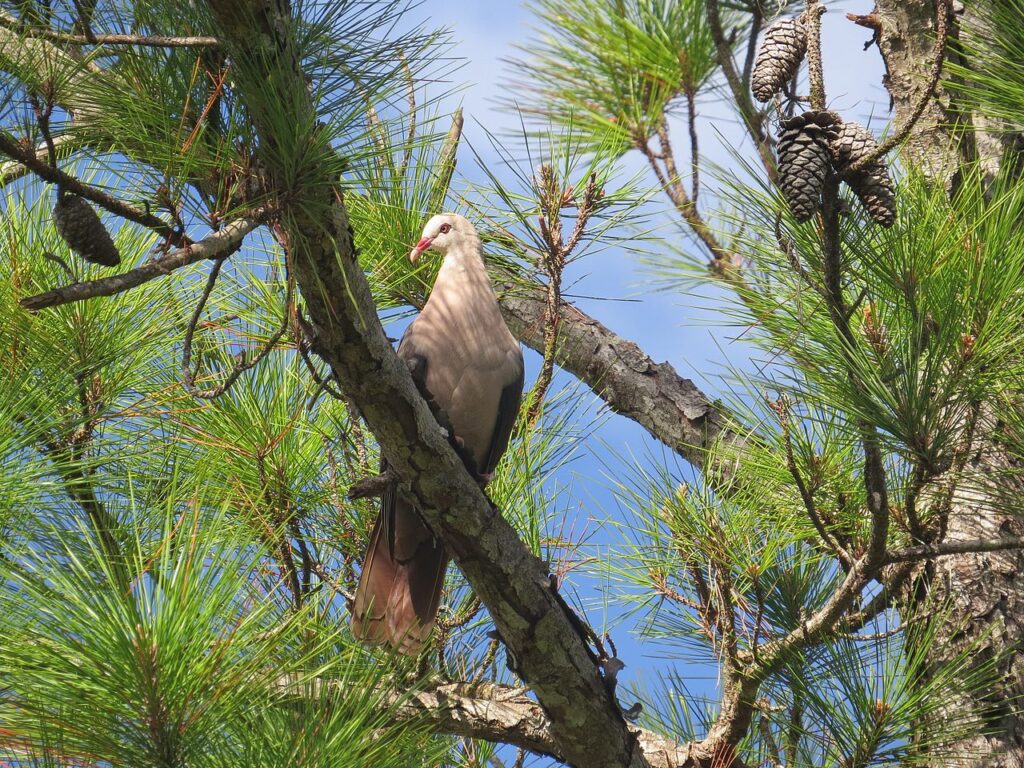
This loop trail allows visitors the best experience of Mauritian tropical rainforest. Home to wonderful views and good birding, you are unlikely to be disappointed.
Savanne
6km return, from the end of Les Mares road | Easy
This simple route offers scenic views of southern Mauritius and is the perfect choice for those seeking something more akin to a stroll than a full-blown hike.
Réunion
Réunion is a fascinating place. Officially part of France, and therefore part of the European Union, it is inhabited by a cocktail of people of African, Indian, European and Chinese origin. The Creole culture is strong here and séga (a traditional dance with African roots), sorcery and occasional cockfights contrast with the ubiquitous croissants, Citroëns and boules tournaments.
Réunion is a very easy place to visit – a kind of user-friendly, flat-packed paradise, where life is exotic yet easy and familiar. The atmosphere is tropical, yet the roads, doctors’ surgeries and hospitals are of a reassuringly European quality.
While Réunion’s beaches may not rival those of Mauritius, its natural beauty is world class. The rugged, mountainous interior attracts hikers, naturalists and adventure sports enthusiasts from around the globe. Having one of the world’s most active volcanoes has also proven to be a tourism asset.
Travel and visas in Reunion
Visas
Holders of European Union or Swiss passports do not need a visa for a stay of up to three months but do need to carry a valid passport or identity card. The same applies for nationals of certain other countries, including Australia, the US, Canada, New Zealand, South Africa and Mauritius. Chinese and Indian nationals do not require a visa for a stay of up to 15 days, but to qualify for this exemption need to book their travel as part of a package or through a licensed tour operator in Réunion. For nationalities that do require a visa, note that as Réunion is not part of the Schengen area, a visa for France that does not specify Réunion is not valid. Before you travel, ensure your passport is valid for at least three months after the scheduled date of departure from Réunion. The French Embassy or Consulate in your home country will be able to provide up-to-date information and handle visa applications. All visitors must be in possession of a return ticket.
Getting there and away
The majority of visitors arrive by air, from Africa, Europe or other Indian Ocean islands. The main airport is Roland Garros International Airport, which is 11km east of the main town, St-Denis. The airport at Pierrefonds, in the south of the island, used to handle only flights within the Indian Ocean, but now receives some flights from Paris. The only direct flights from Europe to Réunion are from France and take 11 hours from Paris. A number of airlines have introduced flights from regional airports in France. These flights are considerably dearer during high season, ie: French school holidays. If you are travelling from any other part of Europe you will need to fly to France to connect with an onward flight. However, most airlines offer special fares for the flight to Paris if you are carrying on to Réunion. Alternatively, fly to Mauritius and on to Réunion from there.
What to see and do in Réunion
Piton-de-la-Fournaise
Most people consider this to be Réunion’s single most striking attraction. Piton-de-la-Fournaise (Furnace Peak) is one of the world’s largest and most impressive shield volcanoes, reaching 2,631m. It is also one of the world’s most active, having erupted a number of times in recent years. As activity can last for two weeks or more, the eruptions draw crowds of spectators (at least 20,000 came to see the eruption that began on 8 March 1998).
The drive to the volcano is an adventure in its own right. From La Plaine-des-Cafres you climb through an Alpine landscape dotted with cows sporting cowbells, which look as if they should be advertising Swiss chocolate. There are several spectacular viewpoints, including the panorama of Piton-des-Neiges looming over La Plaine-des-Cafres, and perhaps most striking of all, the view of La Vallée de la Rivière des Remparts at Nez de Boeuf. This valley, which stretches for 23km, is lined by cliffs rising up to 1,000m and looks almost tunnel-like as you peer down into it. And then you catch sight of a lone village on the valley floor, Roche Plate, and are left wondering how people manage to live in such isolation. Certainly, according to the information board at the viewpoint, life is not easy for those villagers, who battle cyclones and landslides on a regular basis.
The landscape becomes gradually stranger until you begin your descent to the barren moonscape that is La Plaine des Sables, preceding the volcano crater. Then it’s an uphill stretch to Pas de Bellecombe (2,311m), which offers a fantastic view of the volcano and outer crater. There is a kiosk displaying information on the volcano and the walks, which is worth reading before you set off as it indicates the routes and their level of difficulty. The building also contains toilets and sells drinks. You can leave your car in the car park whilst you walk. It is best to set off as early as possible in the morning when the skies are clear because in the afternoon the clouds roll in like a thick fog. You will walk across solidified lava, so take care and make sure you have suitable footwear. Water, some food, suncream and a sunhat are essential, as is some warm clothing. For safety reasons, it is important that you stick to the marked paths.
The Three Cirques
Cirque de Mafate
Spanning 72km2, Mafate is the smallest and most tropical of the cirques. On its northern rim is the Plaine d’Affouches, which overlooks St-Denis and the north coast. On its western rim is Piton Maïdo (2,190m), which overlooks the dry west coast. To its south lies the Cirque de Cilaos.
Mafate is a wild, sparsely inhabited, mystifying place. Its name has suitably intriguing origins: it is said that a Malagasy sorcerer and runaway slave, named Mafaty (meaning ‘dangerous one’), lived at the foot of Le Bronchard (1,261m). He was eventually caught in 1751 by François Mussard, a bounty hunter.
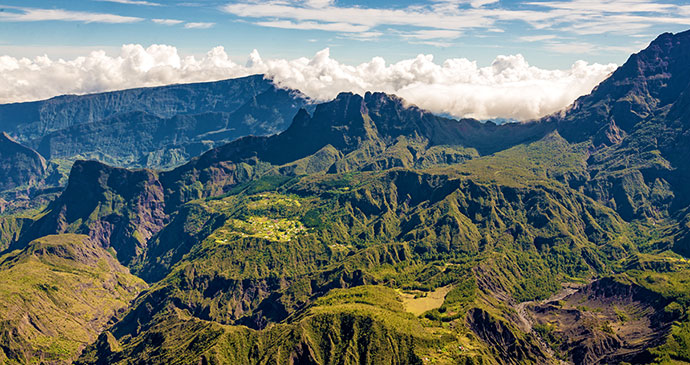 View of the Cirque de Mafate from the Maido © bjul, Shutterstock
View of the Cirque de Mafate from the Maido © bjul, Shutterstock
The cirque’s first inhabitants were indeed runaway slaves after the agricultural colonisation of the island in the 1730s, then the Créoles Blancs (White Creoles) arrived following the abolition of slavery in 1848. Today, approximately 650 people reside in remote mountain hamlets, such as Marla, La Nouvelle and Aurère. They live off the land, in virtual isolation from the outside world. There are no roads, just 100km of walking trails. Supplies such as medication are brought in by helicopter, yet many of the Mafatais have never seen a car.
Cirque de Salazie
The largest of the cirques, Salazie measures about 12km by 9km and has a population of about 8,000. Its name comes from a Malagasy word meaning ‘good place to stay’.The cirque was only settled by European farmers during the mid 19th century, after a hot spring was found at Hell-Bourg. A military hospital was established in 1860 to treat soldiers wounded during unrest in Madagascar. Thanks to its pleasant climate, Hell-Bourg became a popular place for coastal inhabitants to visit during the hot months. In 1948, a severe cyclone somehow destroyed the hot spring and Hell-Bourg was all but deserted until 1980, when the government realised its potential value for culture and nature-oriented tourism.
Cirque de Salazie is the greenest of the cirques and has no fewer than 100 waterfalls, which drop down incredibly high, steep gorges. Réunion’s best-known waterfall, the exquisite Voile de la Mariée, or ‘Bridal Veil’, is in this cirque. Salazie is the most accessible of the cirques, a picturesque 20-minute drive from St-André.
Cirque de Cilaos
The name ‘Cilaos’ is derived from a Malagasy word meaning ‘the place you never leave’. This is the southernmost and driest of Réunion’s cirques, covering roughly 100km². It lies between the island’s two highest peaks: Piton-des-Neiges (3,069m) and Grand Bénard (2,896m). Where remote mountain hamlets now nestle on small, flat plots called ilets, runaway slaves once sought shelter.
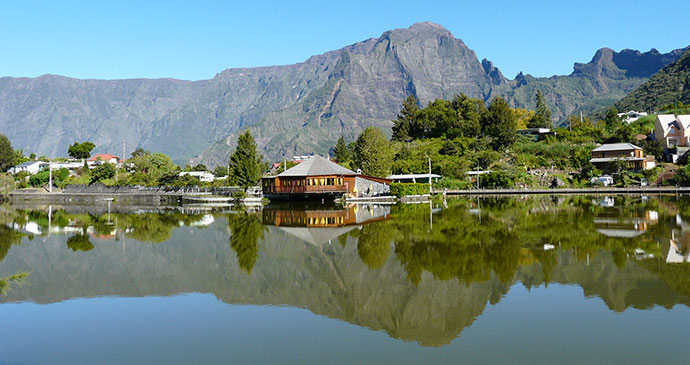 Cilaos © Serge Gelabert/ Ile de la Réunion Tourisme
Cilaos © Serge Gelabert/ Ile de la Réunion Tourisme
About 10,000 people live in this cirque, where the climate is conducive to cultivation of lentils (for the nationally popular cari dishes), vineyards (for local wine production) and tobacco. The climate is widely renowned as the healthiest of all Réunion’s microclimates and the thermal springs there are said to have healing properties. Note that evenings, even in summer, can be very cold, whilst the days are normally pleasant, with sunny mornings. Ordinarily, a cloak of mist descends on the town by about 15.00, adding to the dreamy ambience.
Hiking
For many, hiking is the reason for visiting Réunion, which boasts over 1,000km of well-maintained trails.
The island’s three cirques, formed by the collapse of ancient volcanic craters, are a hiker’s dream, with spectacular mountainous scenery punctuated by thundering waterfalls. Mafate is the most remote of the cirques and only accessible on foot or by helicopter. It can, however, be seen from the spectacular viewpoint at Piton Maïdo.
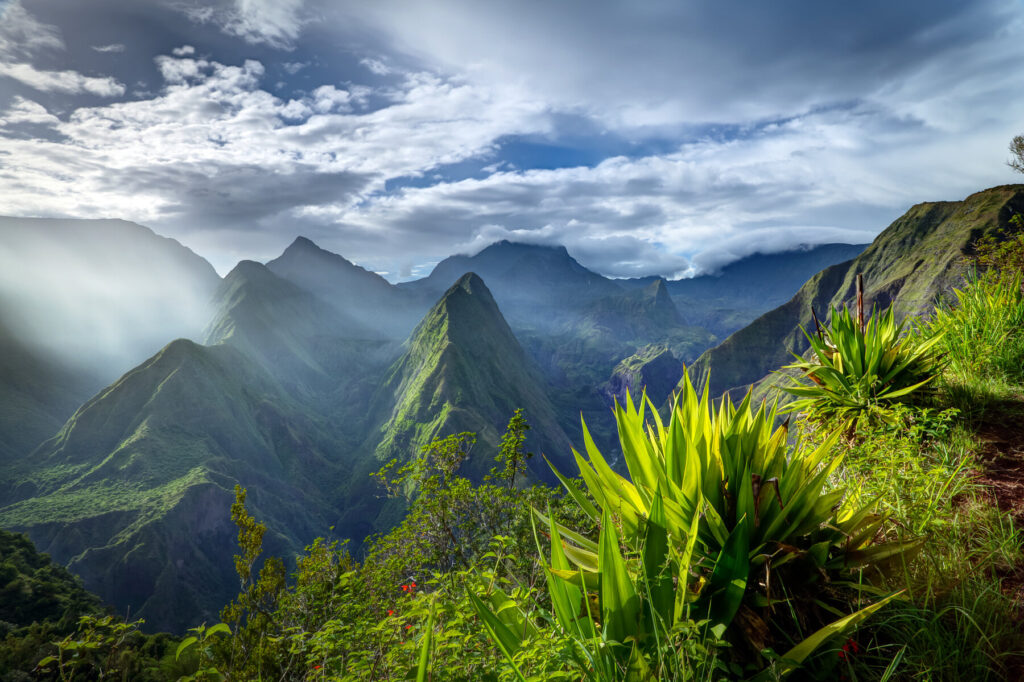
For non-hikers the cirques are still a ‘must-see’, not least for their spectacular scenery and cool, clean mountain air. The cirques of Cilaos and Salazie can be reached by road. The pretty town of Cilaos is set in a basin surrounded by mountains and is known for its thermal springs. Salazie is the wettest and greenest of the cirques, with numerous waterfalls and pretty Creole villages, such as Hell-Bourg, rated one of the most beautiful in France.
High on your list of things to do in Réunion should be hiking around Piton-de-la-Fournaise, one of the world’s most active volcanoes – provided it’s not erupting, of course. Keen hikers will also enjoy the two-day climb of Piton-des-Neiges, which can be timed so you arrive at the summit to watch the sun rise over the Indian Ocean.
Mountain biking
Mountain bikes are all the rage in Réunion and are available for hire in most activity centres. The island has over 1,400km of marked trails, which meet French Cycling Federation standards. Popular trails are around Maïdo, Entre-Deux, Cilaos, Salazie, Piton-de-la-Fournaise and the coast around Ste-Rose.
The French for mountain bike is VTT (vélo tous terrains) (pronounced ‘vay-tay- tay’). You will also see suggested routes marked on large boards in many tourist areas. Once a year, usually in November, Réunion plays host to one round of the Mega Avalanche international series of downhill mountain-bike races. The races in this series are unusual for the downhill discipline as they are mass-start races of up to 25km. Packages which include flights, accommodation and bike transport are available from mainland France. For more information, visit www.ucc-sportevent.com.
The going rate for mountain-bike hire is around €5 per hour, €10–12 per half day, €20 per day. Helmets and gloves are extra. Some companies organise group rides, which cost around €85 per half day and include instructor, gear and insurance.
Canyoning
Canyoning, or abseiling down waterfalls, is very popular among thrill-seekers in Réunion. The island, with its innumerable waterfalls and spectacular gorges, boasts the ideal landscape. Canyoning starts at around €50 per half day, €70 per full day.
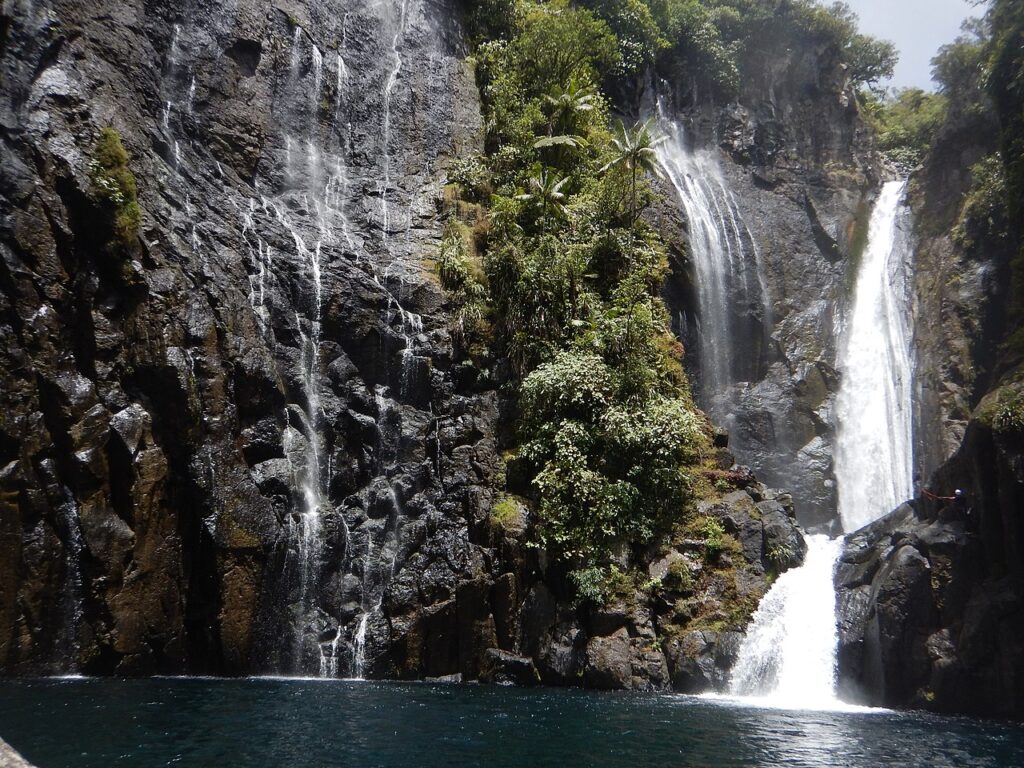
Trusted activity operators include:
Horseriding
On horseback is the ideal way to explore Réunion’s rugged interior. Rides can be arranged for just an hour, a half day, a full day or several days. Some of the establishments around La Plaine-des-Cafres offer rides to the volcano Piton-de-la-Fournaise.
Riding schools vary considerably in standards, although instructors are usually qualified. Although most establishments are affiliated to the French Equestrian Federation, some are reluctant to loan hats, even if they have them. If you insist, you will usually get one, which is important as the terrain in the interior is invariably rocky and uneven. An hour’s ride will usually cost around €30, 2 hours €50, a half day €75 and a full day €135. The best companies to arrange the experience are:
Rodrigues
Rodrigues is remote, a part of Mauritius but 622km further northeast. It is an incredibly special place. There’s something stark about the island and things are decidedly low key. It is not a tropical paradise but those in search of something offbeat will find it a fascinating, peaceful place to explore, with a people whose shy friendliness is genuine.
Life here is slow and refreshingly uncomplicated. People are concerned with the essentials of human existence, like feeding their families and being part of a community, rather than office politics, global recession and conflict in the Middle East. Being such a small island, it has a delightful intimacy and sense of security, and no-one is ever too busy to stop for a chat.
Travel and visas in Rodrigues
Visas
Entry requirements are as for Mauritius. Only Britain and France have honorary consulates in Rodrigues. For other countries, the relevant high commission, embassy or consulate in Mauritius has responsibility for Rodrigues.
Getting there
By air
Air Mauritius flies regularly between Mauritius and Rodrigues, with at least four flights per day in peak season and two per day in low season. Demand for flights from Mauritius is high and reservations need to be made well in advance, and reconfirmed.
By sea
The sea crossing to Rodrigues from Mauritius takes around 36–48hours, and is usually quicker on the way back. It can be rough, particularly on the way to Rodrigues. The Mauritius Trochetia is a mixed cargo and passenger ship, and takes up to 108 passengers in cabins. It is worth knowing that much of the cargo is livestock, usually cattle and sheep being exported from Rodrigues to Mauritius. It makes one or two journeys per month between Port Louis and Port Mathurin. The cabins are comfortable, particularly the deluxe ones.
Getting around
Over the years the island’s roads have improved enormously and there are now sealed roads to most corners of the island, with dirt tracks beyond those. Many more vehicles have been imported, although there are still relatively few cars on the island. Only a small percentage of the population owns a car but the number of scooters has increased noticeably in recent years. Regulations for drivers are as for Mauritius, except for the speed limit, which is 50km/h.
There is just a handful of taxis on the island and they do not drive around looking for clients. Your best chance of finding one is at the bus station in Port Mathurin. Many of them are happy to be hired for the day to do a tour of the island.
What to see and do in Rodrigues
A visit to Rodrigues is about simplicity, nature and getting back to basics, and any stay here is inevitably enhanced by encounters with the supremely friendly and happy local residents.
Port Mathurin
The island’s tiny capital is neatly laid out with a grid system of streets running parallel and perpendicular to the sea. Rue de la Solidarité runs the length of the town and emerges to cross over reclaimed land and on to the seaside village of Anse aux Anglais (English Bay).
A walk down Rue de la Solidarité leads past the colonial house of the administrator, La Résidence (built in 1873), with a cannon outside the gates. This is now the office of the island’s executive council. Also on Rue de la Solidarité, and almost hidden by one-storey houses, are the six miniature minarets of the Noor-ud-Deen Mosque, rebuilt in 1979–81.
The large, modern Alfred North-Coombs building on the corner of rues Morrison and François Leguat houses the library. Here you can use computers and access Wi-Fi free of charge. In a courtyard in front of the library are kiosks, where members of the Association Rodrigues Entreprendre au Féminin (an association for local businesswomen) sell their wares, including delicious honey and pickles. Sadly, their opening hours are very hit and miss.
Running parallel to Rue de la Solidarité, along the seafront, is Rue Wolphart Harmensen. This leads to the port, customs office and the offices of the Rodrigues Regional Assembly. At the port, opposite Rue Hajee Bhai Fatehmamode, is a war memorial with three rifles forming a tripod and two cannon shafts beside them. The inscription reads: ‘Aux engagés volontaires Rodriguais 1914–18, 1939–45’ (For the Rodriguans who served 1914–18, 1939–45).
The purpose-built market building is at the eastern end of Rue de la Solidarité, just before Winston Churchill Bridge. The market is the highlight of the week in Rodrigues and it is worth timing your visit to make sure you can make it to either the Wednesday or the Saturday one.
François Leguat Giant Tortoise and Cave Reserve
A popular attraction for Rodrigues, established by the owners of La Vanille Nature Park in Mauritius. The tour begins with a visit to the tortoise nursery, where giant Aldabra tortoises (Dipsochelys elephantina), and radiated tortoises (Astrochelys radiata) from Madagascar (Dipsochelys radiata), are bred. Visitors can sponsor a baby tortoise and receive regular updates on its progress.
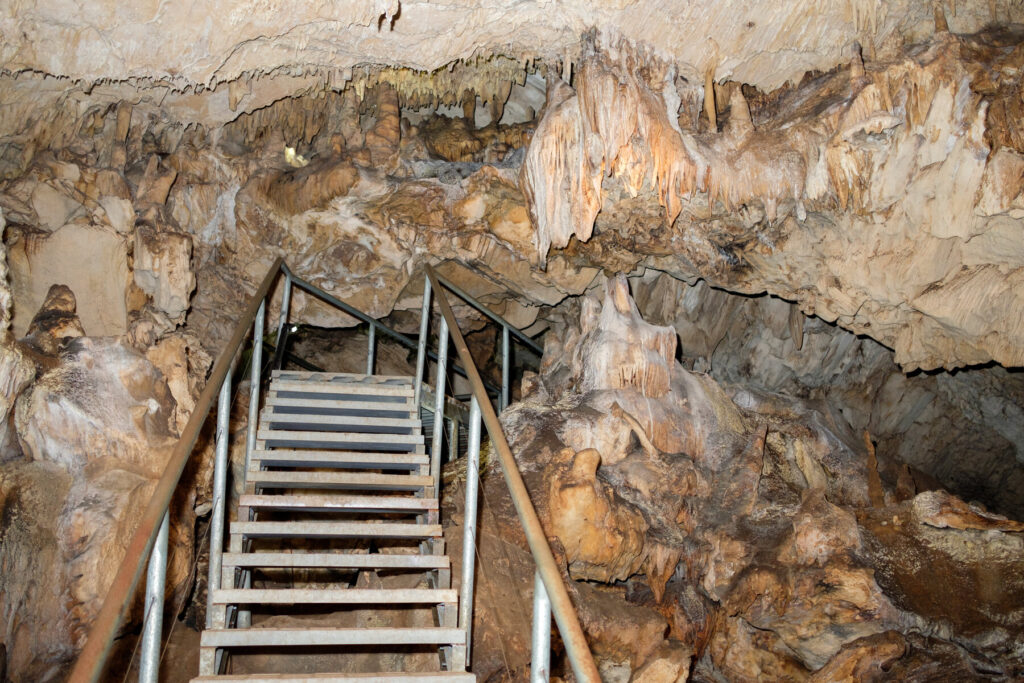
The tour then takes you down into a natural amphitheatre, formed by a collapsed cave, where you can walk among adult tortoises. There is also an enclosure of Rodrigues fruit bats. The reserve is planting native and endemic plants in the area, with the help of the Mauritian Wildlife Foundation, gradually returning the landscape to the way it would have been when tortoises covered the island.
You can add a tour of the caves to your tortoise visit. The tours through the cave are informative (although can be rather too long). There is a boardwalk, handrail and lighting, but you’ll have to negotiate some very narrow gaps during the walk and climb some steep steps. The reserve plans to open another cave more suited to those with limited mobility. There is an excellent museum here, which tells the story of Rodrigues, as well as that of the various extinct species of the Mascarenes.
Île aux Cocos
This shallow sand island, around 4km off the west coast, is unquestionably the most popular day trip available, and rightly so.
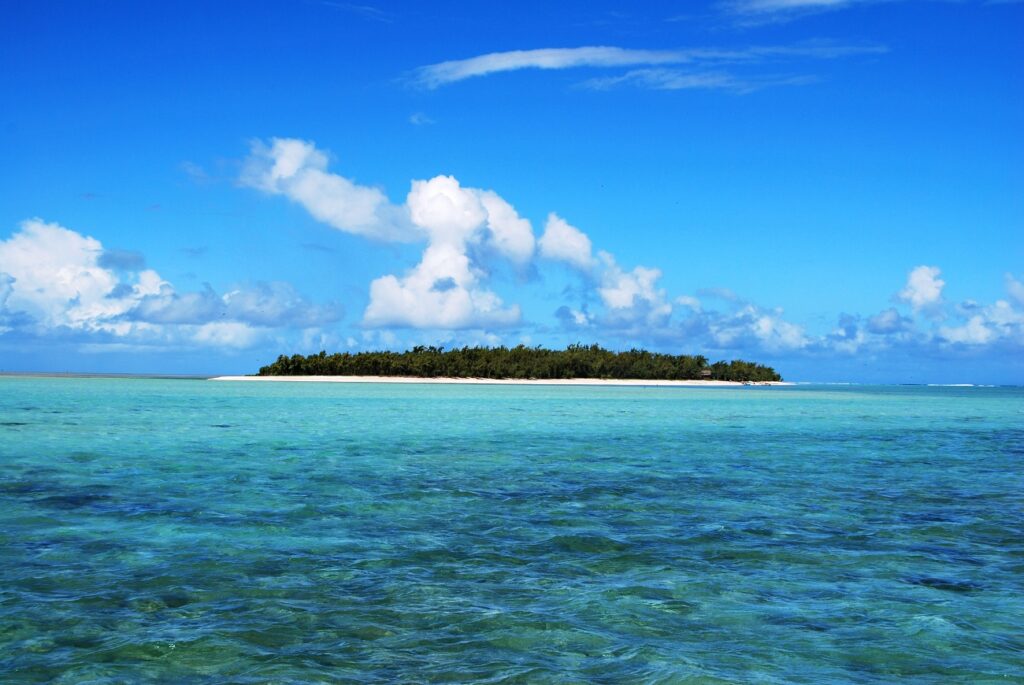
Île aux Cocos is an incredible place. A nesting site for brown noddies (Anous stolidus), lesser noddies (Anous tenuirostris) and fairy terns (Gygis alba), it was made into a nature reserve in 1986 and has been carefully protected. A few simple measures have helped to keep it pristine: no fires are allowed, watchmen take it in turn to stay on the island and guard it, and all visitors must leave by 15.00 and take their rubbish with them. Until 1955 a family lived on the island for extended periods and even grew crops. Today it is uninhabited except for the watchmen and there is only one building on the island, where visitors gather to begin a guided tour.
The beach here has to be one of the most beautiful on earth. The lack of hotels, bars and crowds makes it all the more special. The best spot to swim is found by walking as far as you can along the beach to the right of the building (as you face it). Stop just before you reach the fence which marks the protected area. The water is shallow here and all you can see as you sit on the water’s edge is sand, the sea, waves breaking on the reef in the distance and the birds flitting across the sky.
Hiking
Hiking is an absolute pleasure on Rodrigues thanks to the lack of traffic, abundance of tracks and glorious views of the ocean. A good option is a guided hike along Sentier Pasner with a villager who has been trained by the Mauritian Wildlife Foundation and can tell you about the local flora and fauna. A walk along the east coast between Graviers and St François, stopping off at beautiful, isolated beaches such as Trou d’Argent and Anse Bouteille is also recommended.
Watersports
The vast, pristine lagoon is one of Rodrigues’s greatest assets and offers excellent diving and snorkelling.
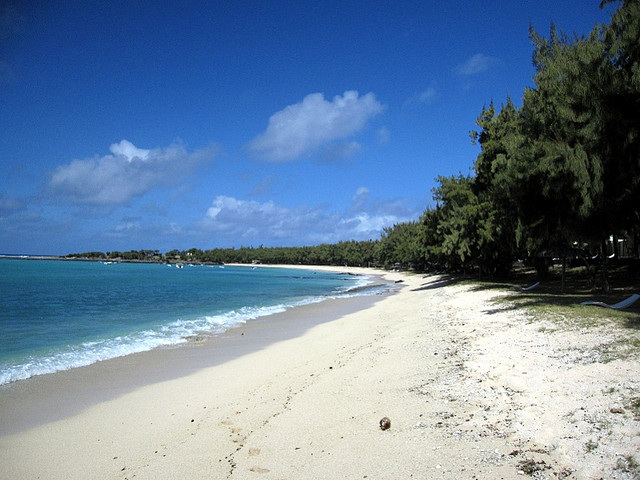
For a truly unique experience, you can also explore the lagoon in a transparent kayak. The business is run by a co-operative of fishermen and women as part of a project to provide them with an alternative source of income and reduce the impact of fishing on the marine environment.
Related books
For more information, see our guide to Mauritius:
Related articles
Exploring the island’s natural history and slave-trade past, Neal Sullivan summits the most iconic mountain in Mauritius.
Whether you want to relax on pristine white sands, dive the coral reefs or try your hand at watersports, these little slices of paradise have it all.
From white sand beaches to historic towns, Iona Grant explores the very best this island has to offer.
Sit back and enjoy this kaleidoscope of colours.
Marble caves, salt lakes and rainbow mountains.
